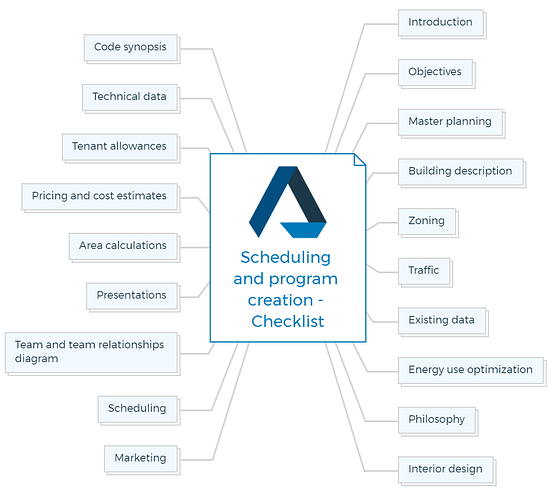The Complete checklist for Program Creation
1. Introduction
- Provide a brief overview of the program’s purpose and goals.
- Outline the context and significance of the program.
2. Objectives
- Clearly define the specific goals and outcomes the program aims to achieve.
- Ensure objectives are measurable and aligned with the program’s purpose.
You are missing out if you haven’t yet subscribed to our YouTube channel.
3. Master planning
- Develop a high-level master plan outlining the program’s layout and key components.
- Consider scalability and future expansion in the master planning phase.
4. Building description
- Detail the physical characteristics of the building, including size, layout, and architectural style.
- Specify any unique design elements that contribute to the building’s identity.
5. Zoning
- Verify that the program aligns with local zoning regulations and land use policies.
- Obtain necessary permits and approvals from relevant authorities.
6. Traffic
- Evaluate traffic patterns and accessibility to the program’s location.
- Consider parking facilities, pedestrian pathways, and transportation options.
7. Existing data
- Gather relevant data from site surveys, environmental assessments, and feasibility studies.
- Use existing data to inform design decisions and address potential challenges.
8. Energy use optimization
- Implement strategies for energy efficiency, such as sustainable materials and renewable energy sources.
- Incorporate smart technologies for energy management and conservation.
9. Philosophy
- Define the guiding principles and values influencing the program’s design and development.
- Ensure the program’s philosophy aligns with the goals and needs of stakeholders.
10. Interior design
- Plan the interior layout, considering functionality, aesthetics, and user experience.
- Choose materials, finishes, and furnishings that align with the program’s design concept.
11. Marketing
- Develop a marketing strategy to promote the program to potential users or occupants.
- Create marketing materials, including brochures, websites, and virtual tours.
12. Scheduling
- Create a detailed project schedule that outlines key milestones and deadlines.
- Allocate sufficient time for each phase of the program’s development.
13. Team and team relationships diagram
- Identify all team members and their respective roles in the program’s creation.
- Visualize the relationships and communication channels among team members.
14. Presentations
- Prepare presentations for stakeholders, investors, and decision-makers.
- Clearly communicate the program’s vision, objectives, and design concept.
15. Area calculations
- Calculate the total usable area of the building and individual spaces.
- Ensure accurate area calculations for lease agreements, occupancy planning, and pricing.
16. Pricing and cost estimates
- Estimate the total project cost based on design, construction, and operational expenses.
- Consider factors such as materials, labour, permits, and contingencies.
17. Tenant allowances
- Define the allowances and incentives provided to tenants for customizing their spaces.
- Clearly outline terms and conditions related to tenant allowances.
18. Technical data
- Compile technical specifications for building systems, such as HVAC, plumbing, and electrical.
- Provide detailed documentation to guide construction and maintenance.
19. Code synopsis
- Summarize the relevant building codes, regulations, and standards applicable to the program.
- Ensure compliance with safety, accessibility, and environmental requirements.
By incorporating these additional points into your program creation checklist, you’ll have a comprehensive guide to help you effectively plan and execute the development process.


